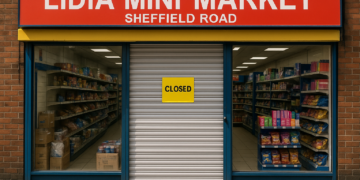Story Highlight
– Over 2,500 serious injuries in UK Amazon warehouses reported.
– Jeff Bezos promised safest workplace; findings contradict this.
– Workers disciplined for taking sick leave after injuries.
– Productivity pressure linked to rising injury rates.
– Amazon’s claims of safety challenged by safety experts.
Full Story
Over the past decade, Amazon warehouses in the UK have reportedly been the site of more than 2,500 serious injuries, indicating a concerning statistic of approximately one serious incident every day and a half. This data, obtained through a Freedom of Information request to the Health and Safety Executive (HSE), has seen renewed attention, particularly following claims made by employees about working conditions and treatment.
The disparity between Amazon’s public image as a premier employer that prioritises worker safety and the experiences of its employees raises significant questions. Jeff Bezos, the company’s founder, famously stated, “We are going to be earth’s best employer and earth’s safest place to work,” a commitment advertised prominently on the corporate website, highlighting cheerful employees in various roles.
However, a detailed investigation by The i Paper uncovered a grim reality within Amazon’s UK facilities, where incidents have reportedly spiked, particularly during the COVID-19 pandemic. This surge prompted discussions around safety improvements; nevertheless, critics argue that the rate of injuries experienced by warehouse workers remains unacceptably high. Liam Byrne, a Labour MP and chair of the Business and Trade Committee, expressed alarm over these findings, labelling them “deeply troubling.”
The nature of injuries reported spans a wide range, including but not limited to electric shocks, falls from heights, and serious chemical burns. One particular case brought to light involved a worker named Destiny, who sustained a chemical burn after a box leaked a hazardous substance during his shift. Destiny’s request for an ambulance was reportedly denied by on-site safety personnel, who suggested he could leave in an Uber without pay instead. Such accounts of inadequate emergency response only add to the concerns regarding Amazon’s health and safety practices.
Destiny’s experience does not stand alone. Another worker, Ceferina Floresca, recounted suffering a heart attack while handling heavy boxes. Rather than receiving support during her recovery, she faced disciplinary actions questioning her sick leave. Such actions have left employees feeling dehumanised, with many expressing frustration over the apparent prioritisation of productivity over their well-being.
The GMB Union, which advocates for the rights of Amazon workers, has denounced the company’s attempts to maintain a positive public image amidst these alarming statistics. They assert that the latest figures undermine Amazon’s portrayal of its workforce experience, revealing a stark contrast between stated commitments and the real-life accounts of employees.
Further complicating matters are claims related to how the company monitors productivity. Chris, another employee, suffered injuries that made daily tasks unbearable but faced immense pressure to meet productivity targets, resulting in deterioration of his health. Workers are reportedly subjected to constant surveillance, with metrics tracked in real-time, creating a work environment that some liken to a relentless factory assembly line. He noted, “You are just like a robot working. The only difference is we don’t have a button.”
These insights have caught the attention of safety experts and regulators. Tom Richmond, an operations director at Safety Group UK, characterised the injury statistics as exceptionally high, raising concerns that the Health and Safety Executive is not taking appropriate action given the data presented. Despite Amazon’s claims of lower injury rates compared to other warehousing businesses—a statement HSE has been unable to verify—critics argue that such assertions do not match the lived experiences of many employees.
Amidst this scrutiny, the UK government is attempting to advance an Employment Rights Bill designed to bolster workers’ rights, which companies, including Amazon, are reportedly lobbying against. Byrne’s comments highlight a call for transparency, urging Amazon to disclose injury data and incident response protocols publicly.
The case continues to unfold as monitoring bodies, unions, and corporate representatives engage in a dialogue over workplace safety. Additionally, Amanda Gearing from the GMB has expressed outrage over the situation, emphasising that no employee should feel unsafe at work.
The situation at Amazon warehouses encapsulates a wider debate about workplace conditions in the modern economy, particularly in high-pressure environments. As the conversation around employee rights and corporate responsibility evolves, the spotlight remains on how major companies manage their workforce health and safety protocols amidst increasing public and governmental scrutiny.






















This record of more than 2,500 serious injuries over ten years is deeply concerning and suggests systemic failures in preventing harm. Promises about safety mean little without effective reporting, responsive first aid and occupational health support, and a culture that does not penalise people for being injured. Productivity targets must not come at the cost of basic protections. Regulators and company leaders should focus on transparent incident investigation, meaningful hazard reduction, and worker involvement in safety decisions to drive real change.
This is deeply concerning and calls for urgent action. Over 2,500 serious injuries in ten years suggests systemic failures in risk assessment, training and reporting. Employers must ensure safe systems of work, adequate staffing, realistic productivity expectations and prompt competent first aid and medical response. Investigations should check whether near miss reporting and hazard controls are effective, and whether injured workers face unfair repercussions for taking sick leave. Regulators and the company should publish transparent data, and unions and health and safety representatives must be empowered to drive improvements. Without meaningful changes to culture and processes, the risk to workers will remain unacceptably high.